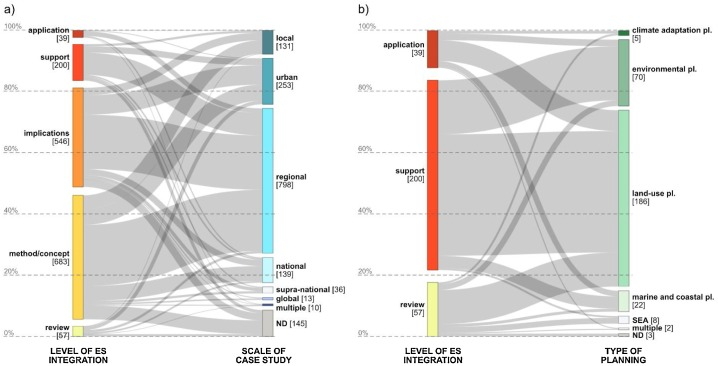A ReNature-supported study investigates how ecosystem services can be applied in spatial planning
ReNature-supported study investigating the practical applications of ecosystem services in spatial planning is now available in the Environmental Science & Policy journal. The research is based on a systematic literature review and has been conducted by a team of international experts from University of Trento, Italy, Lund University, Sweden and Ruhr-University, Bochum, Germany.
The integration of ecosystem service (ES) knowledge into decision-making processes is increasingly endorsed by various policies and initiatives, with spatial planning targeted as one of the most relevant fields. On that account, lending support from the already existing literature is considered essential for fulfilling the goals of the research, namely to gather and critically analyse how ES science contributes to spatial planning practices.

Frequency of the combinations of (a) level of ES integration and scale of case study, among publications including a case study; and (b) level of ES integration and type of planning, among publications addressing a specific spatial planning decision.
The methods utilised throughout the research are a systematic mapping of the scientific literature and a subsequent in-depth analysis of published real-life case studies. The estimation of integration of ES understanding has been established through reviewing relevant data. Consequently, the study has focused on a sub-sampling of case studies providing evidence of ES integration into a spatial planning process and instrument.
More than 2000 publications have been reviewed, the findings of which reveal the existence of three vital advantages of integrating ES into spatial planning processes. The first advantage is being related to the capacity of ecosystem services to influence the planning processes. The second one refers to the use of ES as a lens to synthesise and interpret multiple information. Last but not least, the third advantage looks into the use of ES as a tool to overcome communication gaps between scientists, policy-makers and stakeholders.
A few barriers have been identified, namely in the process of incorporating ES in decision-making, due to a lack of supporting data and accuracy. Nonetheless, the study proves that the involvement of a wide variety of stakeholders is linked not only to a higher degree of participation but also to more substantial and meaningful ES-based planning outputs.
Additionally, the research has concluded that there are a number of benefits from the implementation of ES knowledge in spatial planning processes. These include a synthesised perspective to interpret multiple data and information, effective involvement of stakeholders with higher degree of participation and more.
Read the full paper here.